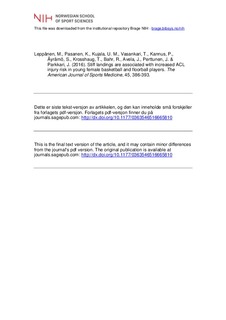| dc.description.abstract | Background: Few prospective studies have investigated the biomechanical risk factors of anterior cruciate ligament (ACL) injury. Purpose: To investigate the relationship between biomechanical characteristics of vertical drop jump (VDJ) performance and the risk of ACL injury in young female basketball and floorball players. Study Design: Cohort study; Level of evidence, 3. Methods: At baseline, a total of 171 female basketball and floorball players (age range, 12-21 years) participated in a VDJ test using 3-dimensional motion analysis. The following biomechanical variables were analyzed: (1) knee valgus angle at initial contact (IC), (2) peak knee abduction moment, (3) knee flexion angle at IC, (4) peak knee flexion angle, (5) peak vertical ground-reaction force (vGRF), and (6) medial knee displacement. All new ACL injuries, as well as match and training exposure, were then recorded for 1 to 3 years. Cox regression models were used to calculate hazard ratios (HRs) and 95% CIs. Results: Fifteen new ACL injuries occurred during the study period (0.2 injuries/1000 player-hours). Of the 6 factors considered, lower peak knee flexion angle (HR for each 10° increase in knee flexion angle, 0.55; 95% CI, 0.34-0.88) and higher peak vGRF (HR for each 100-N increase in vGRF, 1.26; 95% CI, 1.09-1.45) were the only factors associated with increased risk of ACL injury. A receiver operating characteristic (ROC) curve analysis showed an area under the curve of 0.6 for peak knee flexion and 0.7 for vGRF, indicating a failed-to-fair combined sensitivity and specificity of the test. Conclusions: Stiff landings, with less knee flexion and greater vGRF, in a VDJ test were associated with increased risk of ACL injury among young female basketball and floorball players. However, although 2 factors (decreased peak knee flexion and increased vGRF) had significant associations with ACL injury risk, the ROC curve analyses revealed that these variables cannot be used for screening of athletes. | nb_NO |
